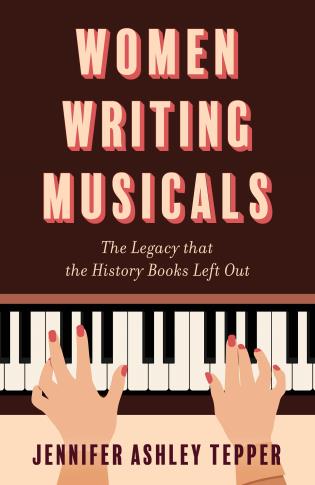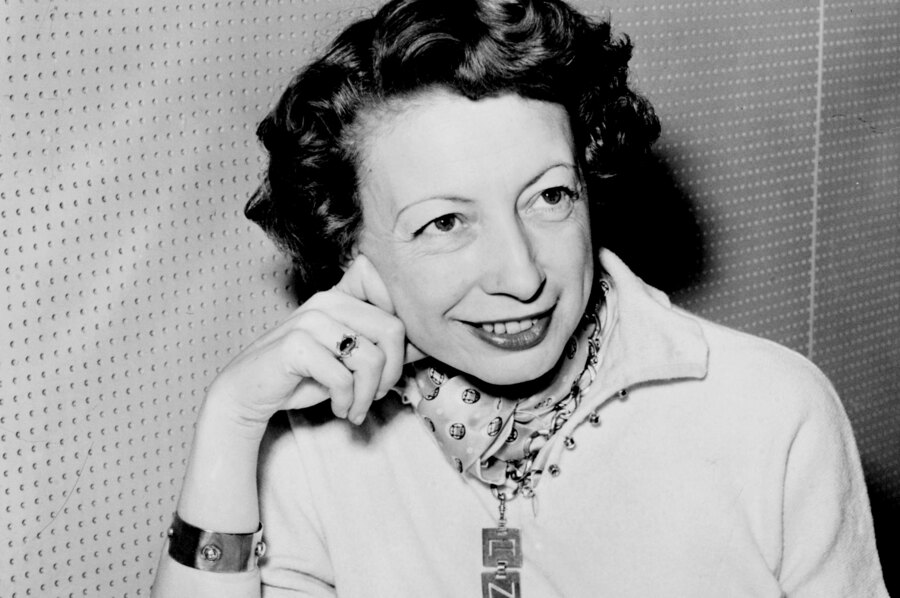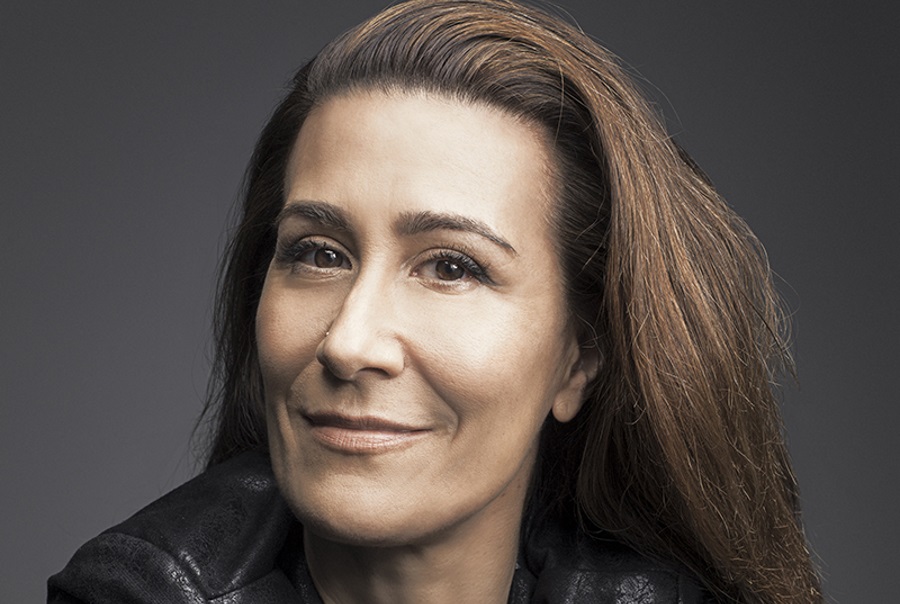Tepper’s new book, Women Writing Musicals: The Legacy that the History Books Left Out, is published by Rowan & Littlefield.
Like Kay Swift, Ann Ronell benefited from the friendship and mentorship of George Gershwin. She met him while she was a student at Radcliffe when she had the opportunity to interview him for a project. Gershwin encouraged Ann Rosenblatt to change her name to Ann Ronell. After all, he himself had been born Jacob Gershowitz. He also suggested she get training by acting as rehearsal pianist for a show, then hired her for his own musical Rosalie in 1928. She was 21 years old.
In 1931, she made her Broadway debut as a writer when she collaborated with Muriel Pollock on a song for Shoot the Works! This show was an effort by Heywood Broun to get actors and writers working, just after the Great Depression hit and people were in a panic. Shoot the Works! featured the contributions of many well-established writers alongside brand-new folks. Ronell got to be one of them after she heard about the project and just showed up at the theatre, trying to get her songs heard and considered. The one that ended up being picked, “Let’s Go Out in the Open Air,” was performed by rising star Imogene Coca.
Ronell hit Tin Pan Alley and began to sell her songs there. In the early 1930s she became successful with “Baby’s Birthday Party,” “Rain on the Roof,” “Give Me Back My Heart,” and “Willow Weep for Me.” Then she began writing songs for films and achieved her most enduring song, “Who’s Afraid of the Big Bad Wolf,” co-written with Frank Churchill, which was featured in 1933’s Three Little Pigs. This became the first hit song from a Disney film. She started composing for projects overseas as well.
A 1933 article in the Wisconsin Rapids Daily Tribune captured Ronell’s rise to success: “Tin Pan Alley still is man’s domain. But sunny, smiling, determined little 23-year-old Ann Ronell, from Omaha, Nebraska, has crashed it! She has made good in a big way with four popular song hits and a score of others. Even the most anti-feminist old member of Tin Pan Alley had to relent and with one accord she has been acclaimed as one of its own.”
Ronell was quoted in the article by Julia Blanshard about first meeting Gershwin when she interviewed him as a student. She shared that it was their conversation that made her resolved to make it as a songwriter herself. She also spoke about getting her start in the business.
“I found that it is impossible to even have your songs heard by the right people, unless you have a pull. Let a girl try to crash into the songwriting game and men will say, ‘Isn’t she cute,’ ‘When can I have a date,’ or ‘This is too tough a game for a nice girl like you!’” The article went on to describe Ronell’s indefatigable perseverance in show business and her entry to the professional world which was assured once Gershwin, Vincent Youmans, and Irving Berlin heard her work and helped her get a start. The article concluded with a paragraph about her physical appearance and manner of dress.
Ronell spent much of the 1930s in Hollywood, not only writing songs but also music directing—one of the first women to do so for major Hollywood movie musicals.

Ronell’s second Broadway venture, a decade after her first, was even more distinguished. She was the sole writer of both music and lyrics for Count Me In in 1942 at the Barrymore. In this, she became the first woman to write the full score of a full-length Broadway musical by herself. Kay Swift had broken ground as the first woman to write all the music of a full-length Broadway musical by herself, and now Ronell added lyrics to that distinction as well.
Count Me In started as a college musical. Future theatre critic Walter Kerr had met Leo Brady, a professor at Catholic University, when Kerr took classes there, and the two wanted college students to have a theatre experience as close to professional as possible, so they decided to write a show for them to perform. They enlisted Ronell to write the songs. Musicals involving patriotic wartime themes were increasingly popular, so they decided to do another of those. Count Me In’s plot involves a shy businessman who wants to help the war effort at home, and who tries to enlist his family and community to join him.
Before long, the Shuberts were interested in bringing the show to a professional stage, and the college students were replaced by Broadway actors. George Abbott was enlisted to direct the show in its next steps. He immediately clashed with Ronell and eventually left the show, stating that the score was inferior and that he doubted Ronell’s abilities to better it.
The show tried out in Boston, where Ronell’s score received excellent reviews, the show overall less so. Many thought the book was overly busy. Count Me In’s cast included Gower Champio as one of the children of the lead character. Another future Broadway choreographer, Danny Daniels, was also in the cast. The rest of the illustrious company included Luella Gear, Charles Butterworth, and Jean Arthur.
Count Me In received mediocre reviews on Broadway and ran 61 performances. In an interview years later, Ronell commented, “It was a terrific experience writing a show at last, and I understand now why there have been so few women who ever got a hearing on Broadway.”
In 1944, Ronell adapted the 1847 Friedrich Wilhelm Riese operetta Martha for Broadway, with Vicki Baum. It played several performances at City Center. Her last Broadway gig was composing a lullaby for the original Broadway production of The Crucible in 1953.
Separate from Broadway, Ronell continued to work busily as a songwriter in the following decades. Her song for the 1945 movie Story of G.I. Joe, which was Academy Award-nominated, was the first theme song to ever play over film credits. She scored a Marx Brothers movie (Love Happy). She worked on a project with Judy Garland to musically adapt beloved songs into Garland’s style.
In a 1950 interview with Ohio’s Circleville Herald, Ronell said, “Some day I intend to compose the first American opera for film production.” The final line of the piece read, “Ten to one she does.” She never did, but her accomplishments are nevertheless impressive.
Jennifer Ashley Tepper is an acclaimed theatre historian, author, and producer. She has been the creative and programming director at 54 Below since 2012, and has published four volumes of The Untold Stories of Broadway book series.
More Stories Like This
Support American Theatre: a just and thriving theatre ecology begins with information for all. Please join us in this mission by joining TCG, which entitles you to copies of our quarterly print magazine and helps support a long legacy of quality nonprofit arts journalism.
Related

Ride or Die for Mental Health
How a tour of Rocky Mountain theatres allowed one group of bikers to raise awareness for Behind the Scenes Charity.
In "Fall 2024"

Theatrical Mustang: Vera Drew Is ‘The People’s Joker’
This month, Woodzick chats with multi-hyphenate filmmaker Vera Drew about cultivating joyful spaces for trans audiences through her DIY film 'The People’s Joker.'
In "Features"

Featured Contributors, Winter 2025
The writers behind a feature on high school theatre inspiration and a production notebook for a new musical.
In "Contributors"





